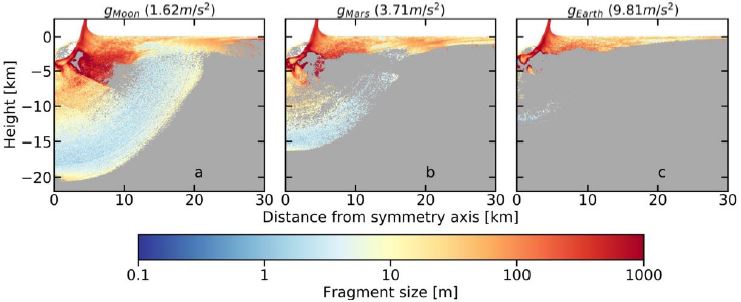18 April 2019
The Moon’s crust is really cracked
Posted by larryohanlon
By Larry O’Hanlon
The bombardment of asteroids and meteoroids that pockmarked the Moon’s surface over the eons also created fractures reaching deep into the lunar crust, report researchers in a new study in AGU’s Journal of Geophysical Research: Planets.
The new study finds asteroids as small as 1 kilometer (0.6 miles) in diameter can fracture lunar crust into meter-sized blocks down to depths of 20 kilometers (12 miles) below the Moon’s surface. Larger asteroids fracture rocks to about the same depth, but over a much wider area. A 10-kilometer (6-mile) impactor, for example, fractures the crust to depths of 20 kilometers and as far as 300 kilometers (186 miles) away from the impact zone.

The crust of the Moon may be more deeply fractured from impacts than previously thought. Image: View from Apollo 15 / NASA
The fractured lunar crust is probably very similar to what the crusts of Earth and Mars would look like, except that on the Moon the damage hasn’t been erased by billions of years of weather and plate tectonics, according to the study’s authors.
“The fragmentation goes much deeper than we thought,” said planetary scientist Sean Wiggins, lead author of the paper and doctoral student at Brown University in Providence, Rhode Island.
The new findings suggest that much of the modern-day lunar surface can be created by many smaller impacts rather than by multiple large impact events, according to the new study.
The widespread lunar fragmentation could also help explain a recent mystery about the Moon’s crust, Wiggins said. Gravity measurements of the Moon have revealed the crust to be less dense than expected. One possible explanation is that the lunar crust is more tilled up by impacts and there are lots of voids that, when averaged out, lower the crust’s overall density.
Damage and fragment sizes 20 second after a 1-kilometer-diameter impactor strikes a moon-like target at 15 kilometer per second. From Wiggins, et al., 2019
Simulating impacts
In the new study, Wiggins and his colleagues simulated physical tests on Earth’s volcanic rocks similar to those found on the Moon. They also used computer simulations to see how deeply and widely the lunar crust might have been cracked and fragmented by impacts of asteroids and other debris that crowded the early solar system.
Their simulations covered a wider area of fractured crust with more detail and involved a great deal more computational power than previous modeling of meteor impacts, which tend to focus more narrowly on impact sites and resulting craters.

Fragment sizes 12 seconds after a 1-kilometer-diameter impactor strikes a moon-like target at 15 km/s under lunar (a), Martian (b), and Earth gravity (c). Material is colored according to fragment size, corresponding to the scale bar. From Wiggins, et al., 2019
The researchers also simulated impacts under the different gravities of the Moon, Earth and Mars. They found the greater gravity of Earth, for instance, makes it harder for the crust to fracture as widely and as deeply as the Moon’s crust. This is because the greater weight of rocks on Earth puts the crust under greater pressure and makes it harder to fracture those pressurized rocks.
Researchers might be able to test that result by looking at fracturing caused by more recent impact events on Earth, Wiggins said. The simulations could lead to insights about hydrothermal systems that can develop as water moves through the cracks of impact zones of such craters on Earth and perhaps on Mars.
Larry O’Hanlon is a freelance science writer, editor and online producer. He manages the AGU Blogosphere.



 GeoSpace is a blog on Earth and space science, managed by AGU’s Public Information staff. The blog features posts by AGU writers and guest contributors on all sorts of relevant science topics, but with a focus on new research and geo and space sciences-related stories that are currently in the news.
GeoSpace is a blog on Earth and space science, managed by AGU’s Public Information staff. The blog features posts by AGU writers and guest contributors on all sorts of relevant science topics, but with a focus on new research and geo and space sciences-related stories that are currently in the news.
Thanks for sharing. I had not considered what kind of effect gravity would have on fracturing from impacts. The fact that a meteor as small as 1 km could create fractures 20 km deep is pretty astonishing.
What kind of effect would the fracturing have on the moon if it was hollow?